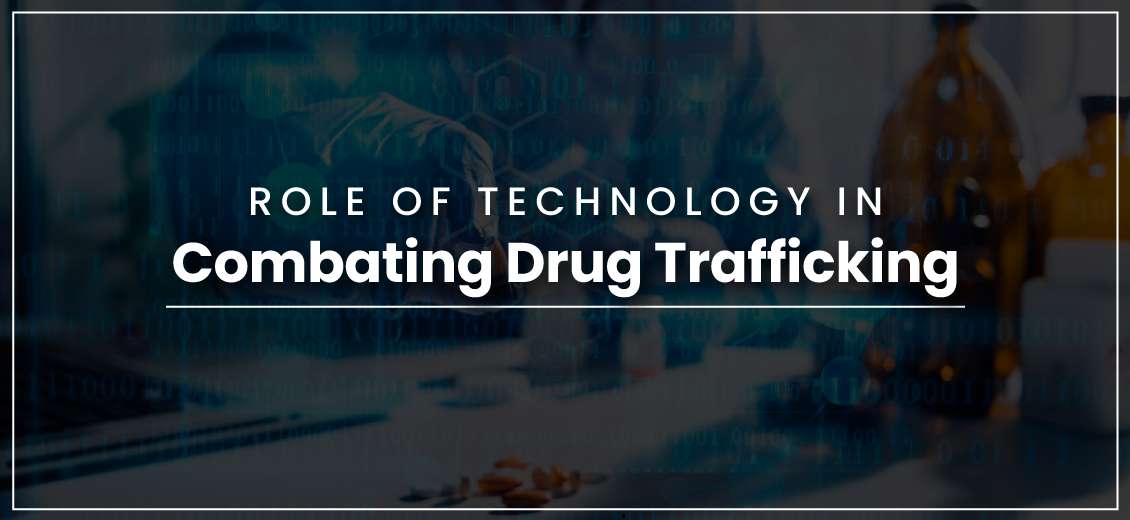Role of Technology in Combating Drug Trafficking
Blogs Home
- 26 Jun 2023

Every year, 26th June is celebrated as the International Day Against Drug Abuse and Illicit Trafficking or World Drug Day. The theme for this year’s “People first: stop stigma and discrimination, strengthen prevention”. NODC World Drug Report 2022 was released on the occasion of the World Drug Day. UNODC World Drug Report 2022 highlights trends on cannabis post-legaliation, environmental impacts of illicit drugs, and drug use among women and youth.
Drug Trafficking is a challenging global issue supported by the illegal production, transport and distribution of drugs. The trade is shadowy and provides a threat to the health and safety of society. The practice has a long-lasting impact on society, economy, and security on a global level. This blog will reflect on the definition and the widespread impact it has on the global scale and analyse the prevalence of drug trafficking in India. In addition, it will scale the role of technology in combating illicit drug trafficking.
I. I. Understanding Drug Trafficking: Definition and Global Impact
A. Definition of Drug Trafficking: Drug trafficking involves the illicit trading of narcotics and other illegal drugs like cocaine, heroin, methamphetamine, cannabis, and synthetic products. It encompasses the cultivation, manufacturing, transportation, and distribution of these substances.
B. Global Impact of Drug Trafficking:
- Public Health Crisis: The regular use of drugs and addiction resulting from this use significantly impact public health on a global scale. The frequent consumption of drugs affects both physical and mental health. An overdose of these substances can cause death or inflict permanent damage to the user's body.
- Socioeconomic Consequences: Drug trafficking undermines socioeconomic development by fostering corruption, violence, and instability. It fuels organised crime, hampers economic productivity, and diverts resources away from essential sectors like healthcare and education.
- Security Threats: Drug transportation and distribution are often connected with organised crime. There have been instances where drug money has been used to fund terror groups, posing a threat to the security of a country like India. An identified nexus has formed between drug traffickers, arms smugglers, and terrorists, hampering national security. In the long run, it fuels inter-community conflicts, weakening the country's law enforcement. The criminal drug networks destabilise nations, tamper with governmental structures, and hinder the implementation of law and order.
II. Drug Trafficking in India
A. Prevalence of Drug Trafficking in India: India's challenge with drug trafficking can be attributed to its geography, large border areas, and vast consumer market. Due to insufficient manpower and a lack of control over remote border areas, the country has become a transit route for drug trafficking. India is considered both a source and a destination for drugs like cocaine, heroin, cannabis, and synthetic drugs.
- Rise in Drug Abuse: The availability and accessibility of drugs have led to a surge in drug abuse, particularly among the vulnerable sections of Indian society, notably the youth. Drug abuse significantly impacts the mental and physical health of users. The productive sector of a country like India is hampered, and it drains public funding and resources as drug users often resort to crime and violence to finance their drug purchases and usage.
- Economic Consequences of Drug Abuse: Given the vastness of the Indian population, drug abuse has a negative impact on the economy. It forces resource diversion, spurs corruption, and is a barrier to social development. Furthermore, drug abuse impacts the productive sector, and drains public funding which could otherwise support sectors like education and healthcare. Drug abuse draws excessive funding towards it, which is needed to mitigate its effects and challenges.
III. Organised Crime Groups Involved in Drug Trafficking Networks
A. International Drug Cartels:
- Mexican Drug Cartels: Such as the Sinaloa Cartel, are notorious for their involvement in the production and distribution of drugs. These cartels have a global reach and influence.
- Colombian Drug Cartels: Including the Medellín and Cali Cartels, have historically dominated the cocaine trade, impacting drug trafficking networks worldwide.
B. Local Indian Networks:
- In the Indian context, there are swathes of poppy fields in Rajasthan, Uttar Pradesh, Madhya Pradesh, and Uttarakhand. Despite the legal codes under the Narcotic Drugs and Psychotropic Substances Act, 1985, opium is legally cultivated in these regions. Unlicensed cultivation also plagues states like Himachal Pradesh and Manipur. Amidst the rising problem of illegal opium production, the Afghan Pathans have been criminally involved in spreading opium and its byproducts in the national and international markets.
IV. Advanced Technologies in the Fight against Drug Trafficking
A. Satellite Imagery: High-resolution satellite imagery aids in monitoring remote areas, identifying illicit drug cultivation sites, and tracking transportation routes.
B. Drones: Drones are becoming universally adopted tools that facilitate law enforcement tasks. According to UNODC, law enforcement agencies have benefited from the intelligence provided by drones in anti-drug trafficking efforts, combating illegal border trespassing, and stopping illegal drug crop harvesting.
C. Closed-Circuit Television (CCTV) Cameras: Strategically placed CCTV cameras help in monitoring high-risk areas such as border crossings, ports, and urban centres, allowing for real-time surveillance and evidence gathering.
V. Data Analytics and AI Applications in Combating Drug Trafficking
A. Pattern Identification:
Data analytics and AI algorithms analyse vast amounts of data, identifying patterns and trends associated with drug trafficking, enabling authorities to target their efforts effectively.
B. Predictive Analytics:
By analysing historical data and patterns, predictive analytics can help authorities anticipate future drug trafficking activities, enabling proactive measures to disrupt criminal networks.
C. Suspicious Activity Detection:
AI-powered systems analyse various data sources, including social media, financial transactions, and communication patterns to identify suspicious activities linked to drug trafficking, facilitating early intervention.
VI. Biometric Technologies in Identifying and Apprehending Drug Traffickers
A. Fingerprint Recognition:
Biometric databases, coupled with automated fingerprint identification systems (AFIS), aid in identifying individuals with criminal records, linking them to drug trafficking activities, and assisting in their apprehension.
B. Facial Recognition:
Facial recognition technology enables law enforcement agencies to match faces captured in surveillance footage or images with databases, helping identify and track known drug traffickers, even in crowded environments.
VII. Advanced Communication Technologies for Intelligence Gathering and Collaboration
A. Secure Communication Networks:
Encrypted communication channels and secure databases ensure a safe and confidential exchange of intelligence among law enforcement agencies, enhancing coordination and information sharing in real time.
B. International Collaboration:
Advanced communication technologies facilitate real-time information exchange and collaboration between international agencies, strengthening the global fight against drug trafficking.
VIII. Blockchain Technology in Securing the Drug Supply Chain
A. Supply Chain Transparency:
Blockchain technology provides an immutable ledger that tracks the movement of pharmaceuticals and other controlled substances, reducing the risk of counterfeit drugs entering the supply chain.
B. Authentication and Traceability:
Blockchain enables verification of the authenticity of pharmaceutical products, ensuring the integrity of the supply chain and facilitating quick identification of counterfeit drugs.
Privacy Concerns and Ethical Considerations:
A. Surveillance and Data Collection: The use of surveillance technologies raise concerns about potential infringements on privacy rights. Striking a balance between effective law enforcement and protecting individual privacy is essential.
B. Data Handling and Retention: Proper protocols for data storage, handling, and retention must be in place to ensure compliance with privacy regulations and prevent misuse or unauthorized access to sensitive information.
Cybersecurity Challenges:
A. Protecting Sensitive Information: Law enforcement agencies must employ robust cybersecurity measures to safeguard sensitive data from hacking attempts, unauthorized access, or data breaches, thereby protecting their investigative operations and the integrity of the legal process.
B. Ensuring System Resilience: Cybersecurity measures should be regularly updated and reinforced to counter evolving cyber threats, ensuring the continued functioning of technology systems critical to combating drug trafficking.
Adaptation and Upgradation of Technology Infrastructure:
A. Evolving Drug Trafficking Methods: Drug traffickers continuously adapt their strategies to evade law enforcement. Keeping pace with these evolving tactics requires regular assessment and upgrading of technology infrastructure, including surveillance systems, data analytics tools, and communication networks.
B. Budgetary Considerations: Adequate funding must be allocated for the acquisition, maintenance, and upgradation of technology infrastructure. Budget constraints may pose challenges in acquiring cutting-edge technologies and maintaining state-of-the-art systems.
Digital Divide and Equitable Access:
A. Disparities in Technology Resources: Ensuring equitable access to technology resources among law enforcement agencies at different levels is crucial. Disparities in budgetary allocations, infrastructure availability, and technical expertise can hinder the effectiveness of technology-enabled interventions against drug trafficking.
B. Training and Capacity Building: Efforts must be made to bridge the digital divide through training programs and capacity-building initiatives that empower law enforcement agencies to effectively utilize technology resources.
International Cooperation and Coordination:
A. Sharing Technology Resources: International cooperation is vital for combating transnational drug trafficking. Sharing technology resources and expertise among countries can enhance the effectiveness of law enforcement efforts and promote a more coordinated global response.
B. Intelligence Sharing: Establishing secure platforms and protocols for sharing intelligence across borders enables collaborative investigations and facilitates the timely exchange of critical information.
Success Stories:
As per a recent interview given to Hindustan Times by Union Minister Amit Shah, technological solutions have been tested for counter-measuring the challenge of drones which have been used to smuggle drugs and weapons from Pakistan. Using the system, the percentage of drone drops was reduced by 422% which is a big achievement for the Indian government. For this purpose, India used four different anti-drone technologies in Punjab and Jammu Borders.
According to the news by USNI, the US is working with unmanned platforms and AI to address ‘several challenges’ which include combating narcotics and human trafficking. The new technology will integrate intelligence, operations, planning and manpower into a single system which will make tasks easy for the task force.
The Ministry of Justice in the UK has published a report stating the use of biometric technology and facial recognition to identify and stop prison drug trafficking. The technology which involves iris scanning and facial recognition software has been tested in 3 prisons and has been part of a wider response in cracking down on drugs entering the prison.
Lessons Learned from International Experiences and Best Practices:
- Collaboration and Information Sharing: International cooperation and sharing of best practices, technological expertise, and intelligence are crucial for combating drug trafficking.
- Integration of Advanced Technologies: Combining surveillance systems, data analytics, biometric identification, and communication technologies enhances intelligence gathering and coordination.
- Embracing Data Analytics and AI: Data analytics and AI help identify patterns, predict trends, and detect suspicious activities related to drug trafficking.
- Utilising Advanced Surveillance Systems: Advanced surveillance technologies enable real-time monitoring, detection of illicit drug activities, and tracking of transportation routes.
- Focus on Cybersecurity: Prioritising cybersecurity measures protects sensitive information, prevents hacking attempts, and ensures the resilience of technology systems.
- Continuous Adaptation and Upgradation: Regular assessment and upgrading of technology infrastructure keep pace with evolving drug trafficking methods.
- Capacity Building and Training: Equipping law enforcement personnel with the necessary skills to utilise technology effectively is crucial.
- Balancing Technology with Privacy and Ethics: Implementing privacy protocols and adhering to ethical guidelines are essential when leveraging technology against drug trafficking.
Conclusion:
Drug trafficking is a major issue in India and the global market. Technology has emerged as a new potential means to combat drug trafficking. As drug trafficking cartels have picked technology like drone delivery, governments of India and various other countries have already tested technologies to combat the drug issue. The government has to emphasise the problem of drug trafficking with the latest security technology as drug trafficking is a threat to national security. Most of the drug trafficking and selling is used to fund terror and criminal groups which is a threat to any country.
References:
https://www.interpol.int/en/Crimes/Drug-trafficking
https://www.unodc.org/e4j/zh/organized-crime/module-3/key-issues/drug-trafficking.html
https://www.unodc.org/ropan/en/mingob-and-unodc.html
Shounak Roy

He finds pleasure in the hunt for knowledge, eagerly seeking to learn something new about anything that interests him. He describes himself as a simple and peaceful individual, always curious to delve deeper into various subjects. If he comes across someone with shared interests, he enjoys engaging in discussions and exchanging knowledge.
Blogs Home



